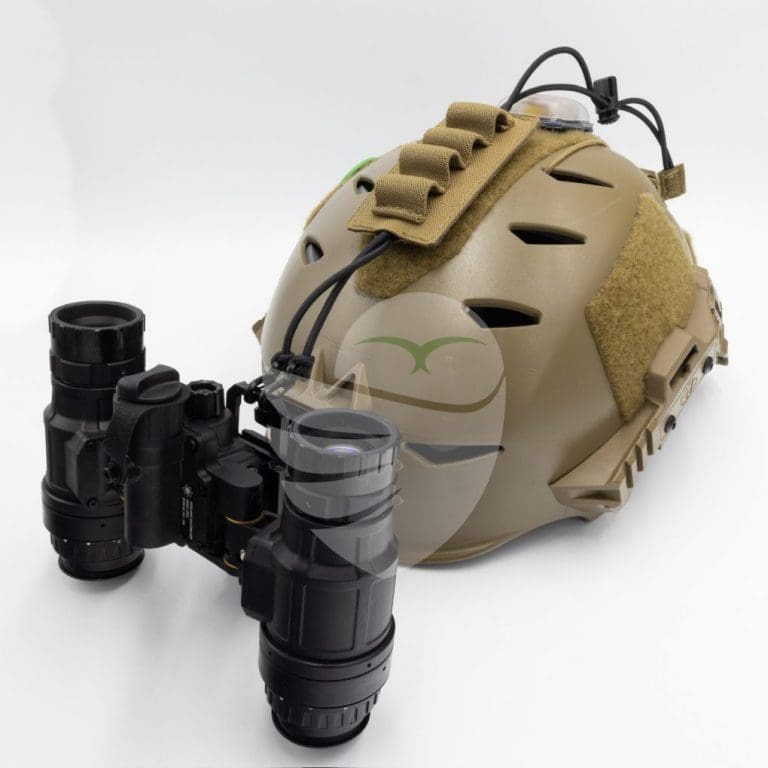If you’re in the field, on patrol, or running night operations, having your NVGs mounted to your helmet is the difference between reacting and owning the situation. Freeing up your hands while maintaining total situational awareness?
That’s not a luxury, buddy, it’s a survival necessity!
In this guide, we’ll break down why mounting your NVGs is such a game-changer, the gear that makes it work, and how to build the right setup (whether you’re in law enforcement, military, or civilian). We got you.
What is Helmet-Mounted Night Vision?
Helmet-mounted night vision is exactly what it sounds like: a setup where your NVGs (like a PVS-14 or Nighthawk) are securely attached to a helmet system, allowing hands-free operation, fast mobility, and better reaction time in the dark.
It’s not just a convenience feature. It’s what tactical pros, special forces, SWAT, and military teams rely on for real-world ops.
Pro Tip: Once you go hands-free, going back to handhelds feels like a major step down.
Why Does It Matter in the Field?
1. Hands-Free Control
Whether you’re clearing rooms or climbing terrain, holding your NVG isn’t practical. Helmet-mounted setups allow you to move, signal, use your weapon, or operate gear without losing your night vision advantage.
2. Improved Situational Awareness
With your device aligned to your eyes and stabilized, you stay locked in on your environment. You’re not adjusting your grip or refocusing every few seconds, it moves with you, naturally.
3. Faster Response Times
Helmet setups let you flip up or pivot one pod quickly (if you’re using dual tubes like the DTNVS). That flexibility makes it easier to switch between light conditions or momentarily go back to natural vision.
4. Reduced Fatigue
Believe it or not, the right helmet setup (especially with a counterweight) actually reduces neck and shoulder strain, even with heavier devices. That’s a big deal when you’re under gear for hours.
Build It Right: The 3-Part Helmet Mounting System
Ensuring mission success and personal safety in low-light environments hinges on a reliable helmet-mounted night vision setup. Imagine a special operations team breaching a building at night, or a search and rescue unit navigating treacherous terrain in pitch darkness.
In these high-stakes scenarios, fumbling with handheld night vision devices is not just inconvenient, it’s dangerous. A secure, hands-free helmet-mounted system allows operators to move swiftly, maintain situational awareness, and react instantly to threats. The ability to manipulate weapons, communicate effectively, and climb obstacles without losing night vision capability can mean the difference between life and death.
The bedrock of such a critical system lies in three essential components: the helmet, the mount/J-arm, and the counterweight.
1. The Helmet
For most tactical users, Ops Core bump helmets or high-cut ballistic helmets are the standard.
- Ops Core bump helmets are lightweight, durable, and perfect for non-ballistic needs like training, SAR, and patrol.
- Need ballistic protection? Consider a military night vision helmet with NIJ-rated protection and integrated ARC rails.
Either way, look for:
- Shroud compatibility (Wilcox or standard NV shrouds)
- Comfortable padding and fit
- Space for comms or ear pro integration
2. The Mount + J-Arm
This is your bridge between the device and the helmet.
- Mount: A Wilcox G24 is the gold standard, rock solid, adjustable, and field-proven.
- J-Arm (For Monoculars): Connect your monocular unit to the mount. For monoculars like the PVS-14, options like the AX14 or Wilcox J-Arm are lightweight and reliable.
3. Counterweight + Balance
Here’s a mistake a lot of first-timers make: not adding a counterweight. Your neck will hate you by hour two.
- Add a rear-mounted battery pack or soft weight pouch.
- Bonus: External packs also extend battery life, especially in cold climates.
Best Devices for Helmet Mounting
Not every NVG is ideal for mounting. Here’s a quick list of top performers:
- PVS-14: Lightweight, modular, and great for one-eye operation
- DTNVS: Dual tubes with articulating pods (superb depth perception)
- Photonis Vyper: Minimalist dual-tube design with robust build
- BNVD-1531: Military-grade performance with built-in IR and manual gain
Need help choosing? Hit us up at Steele Industries, we build these daily and can tailor your rig to your exact needs.
Who Benefits Most from Helmet-Mounted Night Vision?
Law Enforcement
Tactical teams, SWAT units, and rural patrol officers use helmet setups for room clearing, surveillance, and tracking. When seconds matter, hands-free vision is a force multiplier.
Military & Government Operators
Helmet-mounted NVGs are the standard in modern warfare, period! Whether it’s urban combat, long-range recon, or night ops in hostile terrain, mounted systems let soldiers maintain readiness and control.
Civilian Professionals & Trainers
Serious about security, SAR, or night hunting? Don’t settle for handhelds. A well-built helmet setup gives you a massive edge, especially for navigation and scanning across large areas.
Expert Advice: Build Smart, Train Hard
Helmet-mounted night vision systems are more than just a cool-looking setup; they’re a serious investment in performance, comfort, and mission effectiveness.
So don’t go halfway:
- Choose mil-spec NVGs with the specs to match your use
- Pair it with quality mounts and helmets like the Ops-Core bump line
- Train with your gear before you hit the field
Still, building your first setup? Reach out to our team at Steele Industries, and we’ll help you get the right components, balanced properly, and mission-ready.
Helmet-Mounted Night Vision FAQs
What’s the best helmet for mounting night vision?
Ops-Core bump helmets are lightweight and modular (great for non-ballistic needs). For duty use, look for a helmet with ballistic protection and NV shroud compatibility.
Can I mount a PVS-14 to any helmet?
Not quite. You’ll need a helmet with an NV-compatible shroud, mount, and a solid J-arm (like the MAX14). Bump or ballistic helmets are your best bet.
Is helmet-mounted night vision better than handheld?
Yes, for most tactical or mobile operations. You stay hands-free, maintain field awareness, and reduce fatigue. Handhelds are fine for observation, but they slow you down when every second counts.
Do I need a counterweight?
If you care about neck strain, YES! Especially with dual-tube setups. Counterweights help balance the load and keep your gear stable through movement.


